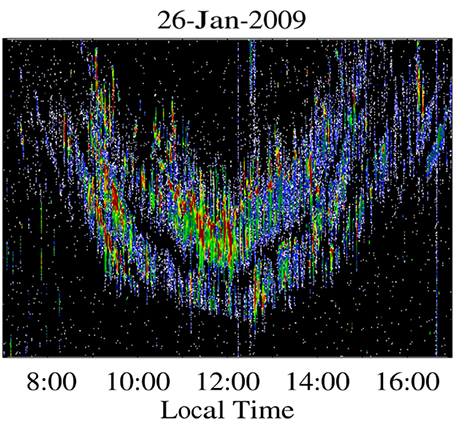Source: Geophysical Research Letters
To probe the plasma that surrounds Earth, space physicists have a useful tool: radar. Researchers can extract information about the plasma from reflected radar energy, such as how hot and dense the plasma is and how fast it’s traveling. But for decades, space physicists have been unable to decipher a mysterious type of radar echo coming from the upper wisps of the Earth’s atmosphere at heights around 150 kilometers.
Scientists first detected the echoes in the 1960s, when the then brand-new Jicamarca Radio Observatory opened, just east of Lima, Peru. The echoes tend to appear throughout the day but migrate lower into the atmosphere around noon and then recede upward. When plotted over time, this distinctive signature earned them the nickname “necklace echoes” or “daytime valley echoes.” More than 50 years after they were first reported, they are still a mystery.

Now Oppenheim and Dimant have devised a model that explains many of the phenomenon’s unique characteristics. They propose that the necklace echoes are the end result of a cascading series of interactions taking place in the upper atmosphere. The process begins when the Sun’s ultraviolet rays strike nitrogen and oxygen molecules, violently knocking off electrons. These suddenly liberated electrons are much more energetic than the surrounding electrons. Under the influence of the Earth’s magnetic field, they cause cold ionosphere electrons to oscillate with enough intensity that they also make waves among the much heavier ions. Radar scattering off of these heavy ions generates the 150-kilometer-high echoes.
This model explains the characteristic necklace or valley shape because the Sun’s rays penetrate deepest at noontime when the Sun is directly overhead. Early in the morning or late in the afternoon, the rays have to travel at an angle through the atmosphere and don’t make it as far down. The model also explains observations of the echoes disappearing during a solar eclipse and intensifying during a powerful solar flare.
The authors simulated how they think necklace echoes form, run on 1024 processors. They show that this chain of events plays out as hypothesized. They write that future simulations of this model could reveal in more detail the exact kinds of plasma waves and resonances that exist, which may explain more specific features in the echoes. (Geophysical Research Letters, doi:10.1002/2016GL068179, 2016)
—Mark Zastrow, Freelance Writer
Citation:
Zastrow, M. (2016), Mysterious “necklace echoes” in the sky explained, Eos, 97, https://doi.org/10.1029/2016EO053255. Published on 03 June 2016.
Text © 2016. The authors. CC BY-NC-ND 3.0
Except where otherwise noted, images are subject to copyright. Any reuse without express permission from the copyright owner is prohibited.

